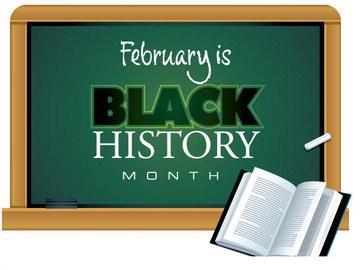
Graphic from Metro Creative

SAN MARCOS PUBLIC LIBRARY
625 E. HOPKINS ST.
512-393-8200
Answers to Go
Q.February is Black History Month. What are some examples of racism in historic educational literature? Also, why do we have Black History Month?
A. Black History Month in the United States is a time of remembrance and celebration honoring the contributions and history of African Americans throughout the United States. It is particularly important because so much African American history has been diminished, obscured, ignored and outright dismissed by historians and, unfortunately, the public school system. As a collector of late 19thand early-20th century juvenile history and geography textbooks, I see this firsthand.* Many of the books in my collection often only mention African Americans in terms of their skin color and “characteristics” of their race. School books at this time focused on “levels of civilization.” People were “classified” in a pseudo-scientific way as “red, black, yellow and white.” For example, In the book titled, “The Elementary Geography Book” published as part of the Indiana Educational Series from the Indiana School Book Co., 1889, the levels of “civilization” and “Races of Men” are discussed in detail (p.20). Public schools throughout the country used this book to teach children not only geography, but overt racism. At one point the book blatantly says, “The white race is called the Caucasian. It is the ruling race of the world.” (p.20) The writing exercise in this chapter of the book asked the children to:
Write what you have learned about savage, half-civilized, and enlightened people. About the races of men. Have you seen a Mongolian? Malay? Indian? Are there men among us who act like savages? Which class is the most happy? Why do you think so?
Another example of how African American history was twisted and skewed, is in the children’s book “The Story of America” by Mary D. Chase (1935). The chapter on Reconstruction (p. 80) blames the “negro” for the South’s troubles post-civil war. One paragraph reads, “The Negroes were the problem. After they were freed by the Thirteenth Amendment in 1865, the worst of them loafed around and lived by stealing. Many Negroes had got the idea that the government would support them.” This type of denigration and misinformation was common in children’s schoolbooks — official textbooks used in the public classroom. In Mace’s “School History of the United States,” by William Mace published by Rand McNally & Co. in 1915, the following passage (p. 392) taught school children about the results of “Negro rule” after African Americans gained the right to vote. Negro rule was “bad in the extreme: The negro proved himself unfit as yet to govern and made it harder for some to believe that he would ever learn so difficult a lesson.” In my opinion, the most striking thing in these schoolbooks is the absence — the invisibility — of the contributions of African Americans. And that is the reason, I believe, we must have Black History month.
Observe Black History Month by learning about the history, contributions, people, culture and importance of Black American history in the United States. We can help you do this at the library. Here are a just a few books and resources to get you started — if you need more, just ask us:
• “African Americans and the Revolutionary War” by Judith E Harper
• “African Founders: How Enslaved People Expanded American Freedom” by David Hackett Fischer
• “Carved in Ebony: Lessons from the Black Women Who Shape Us” by Jasmine L. Holmes
• “Choosing Brave: Mamie Till-Mobley, Emmett Till, and the Voice that Sparked the Civil Rights Movement” by Angela Joy
• “Defiant: Growing up in the Jim Crow South” by Wade Hudson
• “Four Hundred Souls: a Community History of African America, 1619-2019”
• “Hidden colors [DVD] the Untold History of People of Aboriginal, Moor and African Descent”
• “Hidden colors 3 [DVD]: the Rules of Racism”
• “Of Blood and Sweat: Black Lives and the Making of White power and Wealth” by Clyde W Ford
• “Overground Railroad: the Green book and the Roots of Black Travel in America [Young readers adaptation]” by Candacy A. Taylor
• “River of Blood: American Slavery from the People who Lived it: Interviews & Photographs of Formerly Enslaved African Americans by Richard Cahan”
• “That They Lived: African Americans Who Changed the World” by Rochelle Riley
• “The 1619 Project: a New Origin Story”
• “The African Americans [DVD]: Many Rivers to Cross”
• “Unequal: a Story of America” by Michael Eric Dyson We also have oral histories on CD from notable San Marcos residents and digital files in our local history collection accessible through the library catalog — search for Calaboose [Digital Local History File]. Many of the digital items are provided by the Calaboose African American History Museum, an excellent source for research at 200 Martin Luther King Drive in San Marcos.
*I collect these textbooks to remind me how important the written word is and how, as a librarian, I must be vigilant in providing a diverse, balanced and unbiased collection of information for the public.
Suzanne Sanders is the columnist for the library. She is the Community Services Manager for the San Marcos Public Library and came from the Austin Public Library in 2015 after having served there as a librarian for over 20 years. She gratefully accepts your questions for this column.











